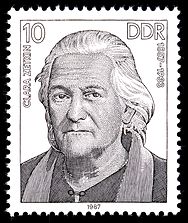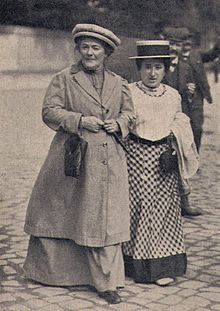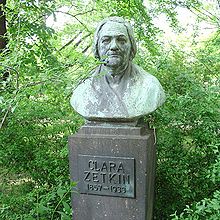- Clara Zetkin
-
 Stamp of the GDR
Stamp of the GDR
 Banknote of the GDR
Banknote of the GDR
Clara Zetkin (née Eißner; 5 July 1857 - 20 June 1933) was a German Marxist theorist, activist, and fighter for women's rights. In 1910, she organized the first International Women's Day.[1]
Until 1917, she was active in the Social Democratic Party of Germany, then she joined the Independent Social Democratic Party of Germany (USPD) and its far-left wing, the Spartacist League; this later became the Communist Party of Germany (KPD), which she represented in the Reichstag during the Weimar Republic from 1920 to 1933.
Contents
Life and work
Zetkin was born Clara Eissner in Wiederau, a peasant village in Saxony, part of the municipality Königshain-Wiederau.[2] Her father, Gottfried Eissner, was a schoolmaster and church organist who was a devout Protestant, while her mother, Josephine Vitale Eissner, came from a bourgeois family from Leipzig and was highly educated.[2][3][4] Having studied to become a teacher, Zetkin developed connections with the women's movement and the labour movement in Germany from 1874. In 1878 she joined the Socialist Workers' Party (Sozialistische Arbeiterpartei, SAP). This party had been founded in 1875 by merging two previous parties: the ADAV formed by Ferdinand Lassalle and the SDAP of August Bebel and Wilhelm Liebknecht. In 1890 its name was changed to its modern version Social Democratic Party of Germany (SPD).
Because of the ban placed on socialist activity in Germany by Bismarck in 1878, Zetkin left for Zurich in 1882 then went into exile in Paris. During her time in Paris she played an important role in the foundation of the Socialist International socialist group. She also adopted the name of her lover, the Russian revolutionary Ossip Zetkin, with whom she had two sons, Kostja and Maxim. Ossip Zetkin died in 1889. Later, Zetkin was married to the artist Georg Friedrich Zundel, eighteen years her junior, from 1899 to 1928.
 Zetkin and Rosa Luxemburg, 1910
Zetkin and Rosa Luxemburg, 1910
In the SPD, Zetkin, along with Rosa Luxemburg, her close friend and confidante, was one of the main figures of the far-left revolutionary wing of the party. In the debate on Revisionism at the turn of the twentieth century she, along with Luxemburg, attacked the reformist theses of Eduard Bernstein.
Zetkin was very interested in women's politics, including the fight for equal opportunities and women's suffrage. She developed the social-democratic women's movement in Germany; from 1891 to 1917 she edited the SPD women's newspaper Die Gleichheit (Equality). In 1907 she became the leader of the newly founded "Women's Office" at the SPD. She started up the first "International Women's Day" on 8 March 1911, launching the idea of it in Copenhagen, in what later became the Ungdomshuset.
During the First World War Zetkin, along with Karl Liebknecht, Rosa Luxemburg and other influential SPD politicians, rejected the party's policy of Burgfrieden (a truce with the government, promising to refrain from any strikes during the war). Among other anti-war activities, Zetkin organised an international socialist women's anti-war conference in Berlin in 1915. Because of her anti-war opinions, she was arrested several times during the war.
In 1916 Zetkin was one of the co-founders of the Spartacist League and the Independent Social Democratic Party of Germany (USPD) which had split off in 1917 from its mother party, the SPD, in protest at its pro-war stance. In January 1919, after the German Revolution in November of the previous year, the KPD (Communist Party of Germany) was founded; Zetkin also joined this and represented the party from 1920 to 1933 in the Reichstag. She interviewed Lenin on "The Women's Question" in 1920.[5]
 Bust of Clara Zetkin in Dresden
Bust of Clara Zetkin in Dresden
Until 1924 Zetkin was a member of the KPD's central office; from 1927 to 1929 she was a member of the party's central committee. She was also a member of the executive committee of the Communist International (Comintern) from 1921 to 1933. In 1925 she was elected president of the German left-wing solidarity organisation Rote Hilfe. In August 1932, as the chairwoman of the Reichstag by seniority, she called for people to fight National Socialism.
When Adolf Hitler and his National Socialist German Workers Party took over power, the Communist Party of Germany was banned from the Reichstag, following the Reichstag fire in 1933. Zetkin went into exile for the last time, this time to the Soviet Union. She died there, at Arkhangelskoye, near Moscow, in 1933, aged nearly 76. She was buried by the wall of the Kremlin in Moscow.
Posthumous honors
- Zetkin was memorialized on the ten mark banknote of the now-defunct German Democratic Republic (GDR) (East Germany).
- In 1954, the GDR established the Clara Zetkin Medal (Clara-Zetkin-Medaille) to honor women particularly active for women's rights.
See also
- Luxemburgism
- Alexander Deubner
Further reading
- Clara Zetkin: Selected Writing, Clara Zetkin, 1991 ISBN 0-7178-0611-1
- Clara Zetkin as a Socialist Speaker Dorothea Reetz, 1987 ISBN 0-7178-0649-9
References
- ^ A woman's place is in the revolution
- ^ a b Young, James D. (1988). Socialism since 1889: a biographical history. Rowman & Littlefield. pp. 169. ISBN 0389208132.
- ^ Encyclopedia of World Biography: Vitoria-Zworykin. Gale Research. 1998. pp. 504. ISBN 0787625566.
- ^ Zetkin, Klara; Philip Sheldon Foner (1984). Clara Zetkin, selected writings. International Publishers. pp. 17. ISBN 0717806200.
- ^ The interview transcript (in English) is available at The Emancipation of Women: From the Writings of V.I. Lenin, interview with Clara Zetkin, International Publishers, on the Marxist Archives
External links
- Clara Zetkin at Spartacus Educational (biography, extracts)
- Zetkin at marxists.org (biography, some writings, links)
Categories:- 1857 births
- 1933 deaths
- Executive Committee of the Communist International
- Free love advocates
- German anti-war activists
- German Comintern people
- German communists
- German feminists
- German women in politics
- Left communists
- Marxist theorists
- People buried in the Kremlin Wall Necropolis
- People from the Kingdom of Saxony
- Social Democratic Party of Germany politicians
- Refugees from Nazi Germany in the Soviet Union
Wikimedia Foundation. 2010.
